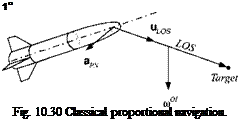Guidance
With the INS model complete we have the first element of the guidance loop that wraps around the autopilot, actuator, and airframe dynamics (see Fig. 10.29). It fulfills the navigation function by delivering the position and velocity vectors of the vehicle. Given these states, it is the responsibility of the guidance processor to guide the vehicle according to the given flight objectives, by issuing commands to the autopilot.
Fig. 10.29 Guidance loop wraps around the inner autopilot loop.
 |
The INS provides position and velocity relative to an inertial or Earth-fixed reference. If the target states are known—moving or stationary, the navigation solution can also be expressed relative to the target reference. Then, the onboard processor can also calculate inertial LOS rates in a format familiar from LOS seekers. We already encountered such seekers in Sec. 9.2.5, and in the next section you will meet an IR seeker. Their LOS rate output in the pitch and yaw channels is in the required format for the classical proportional navigation law.
In Sec. 9.2.4 we already discussed PN and line guidance. They are equally valid for six-DoF simulations because the outer guidance loop is little affected by the inner loop, as long as the autopilot is well behaved. In this section I extend the classical proportional navigation law by correcting for longitudinal missile accelerations and formulate the so-called compensated PN law. Another brief excursion into modern control will expose you to the derivation of the advanced guidance law for missiles with strap-down seekers.











